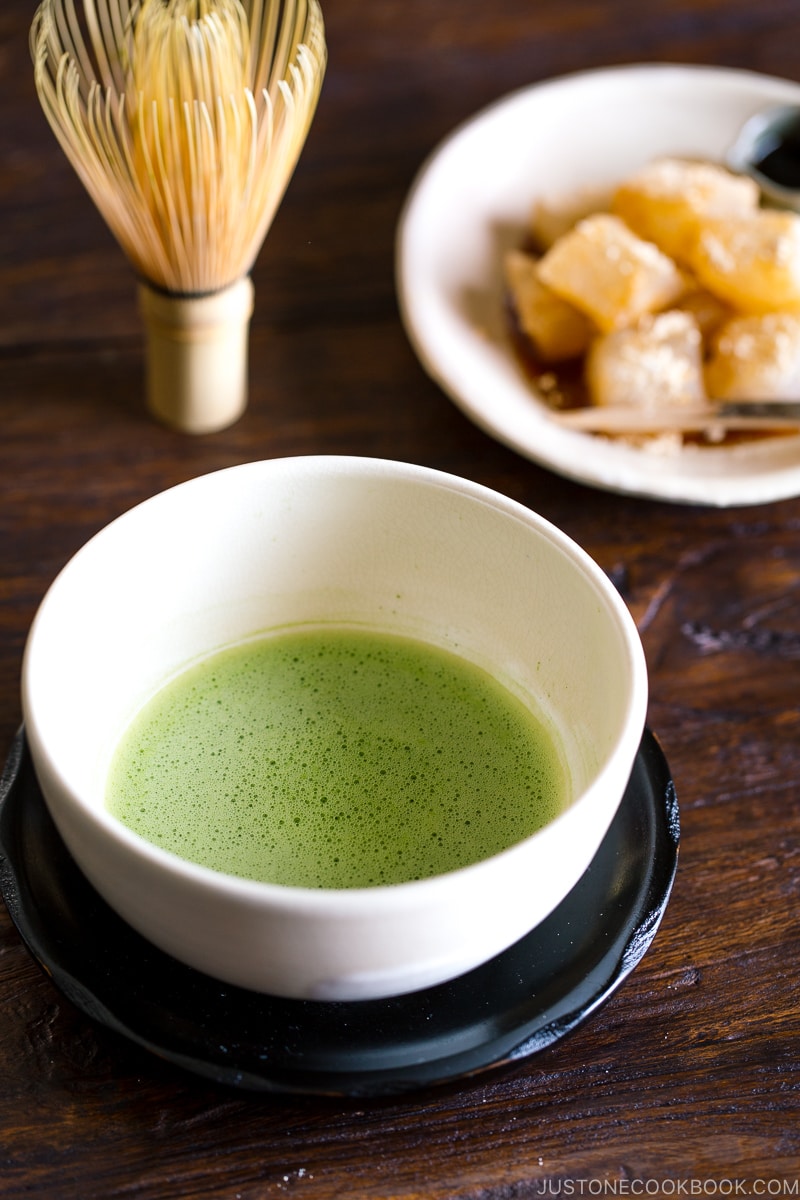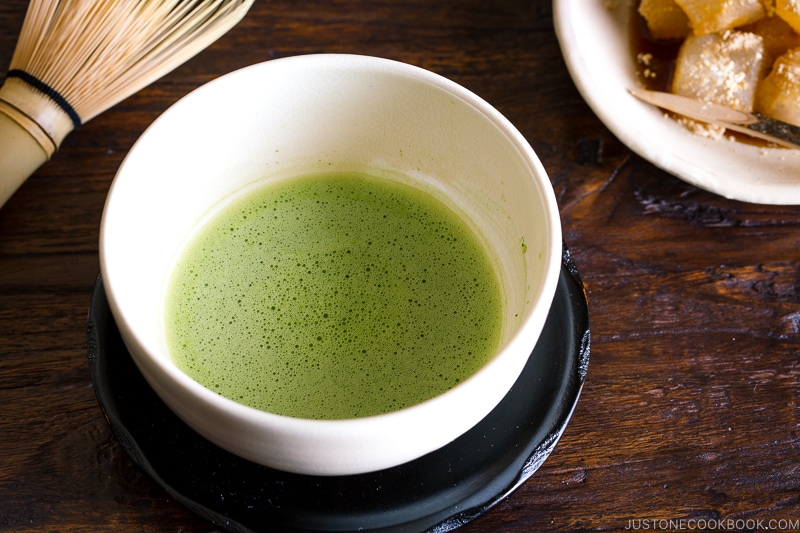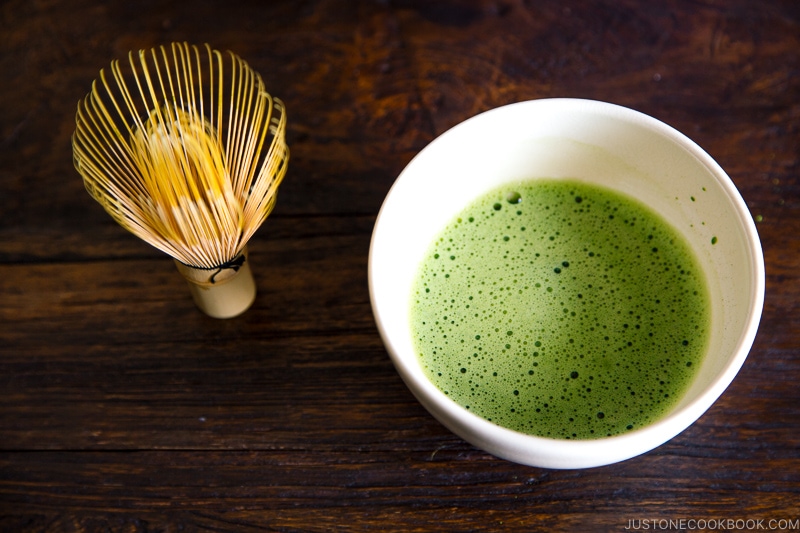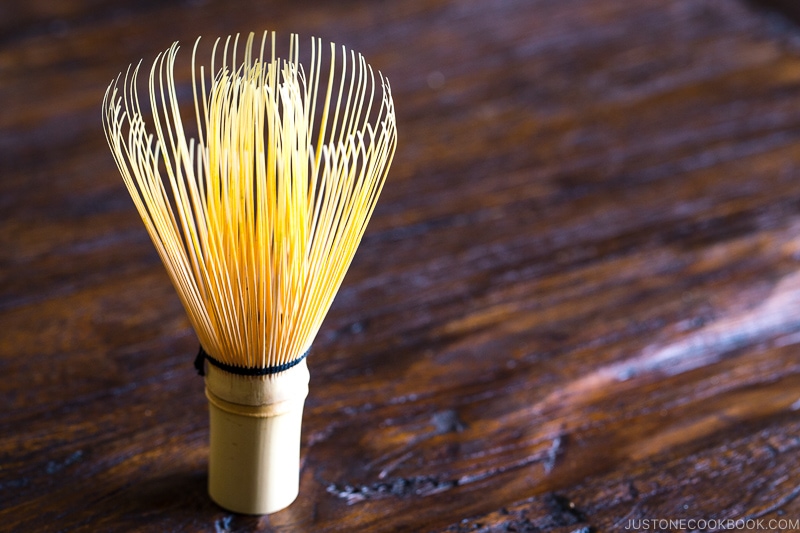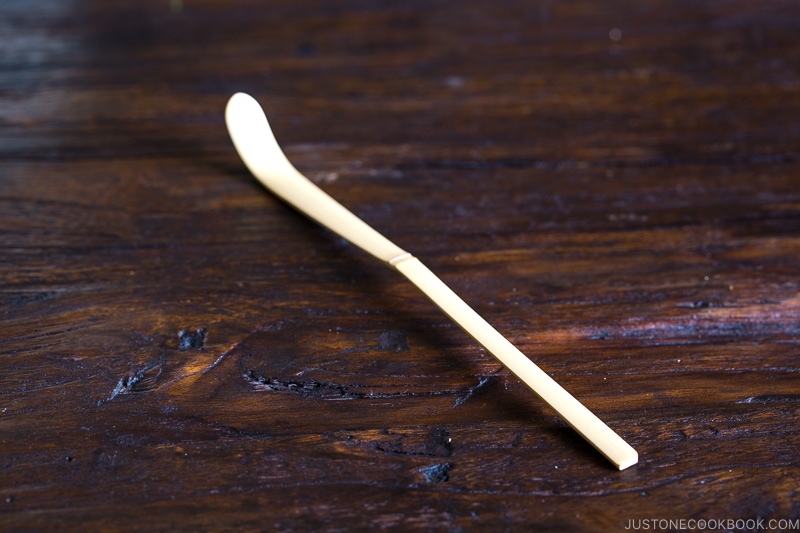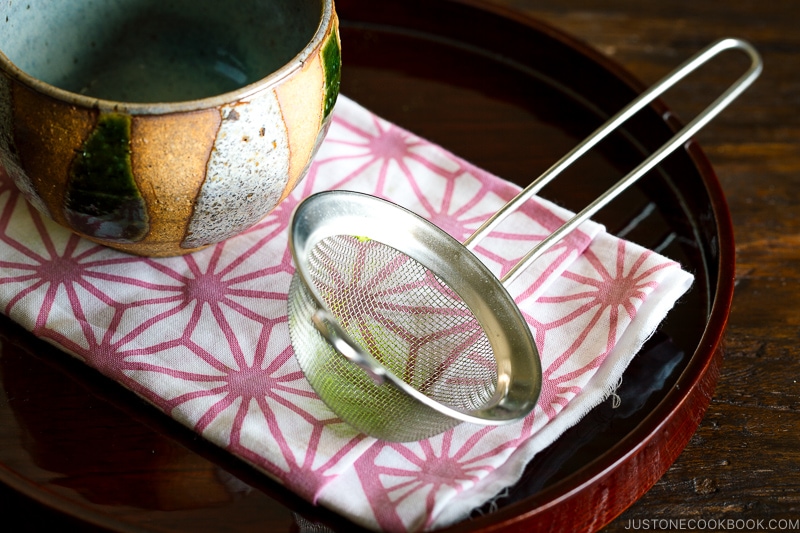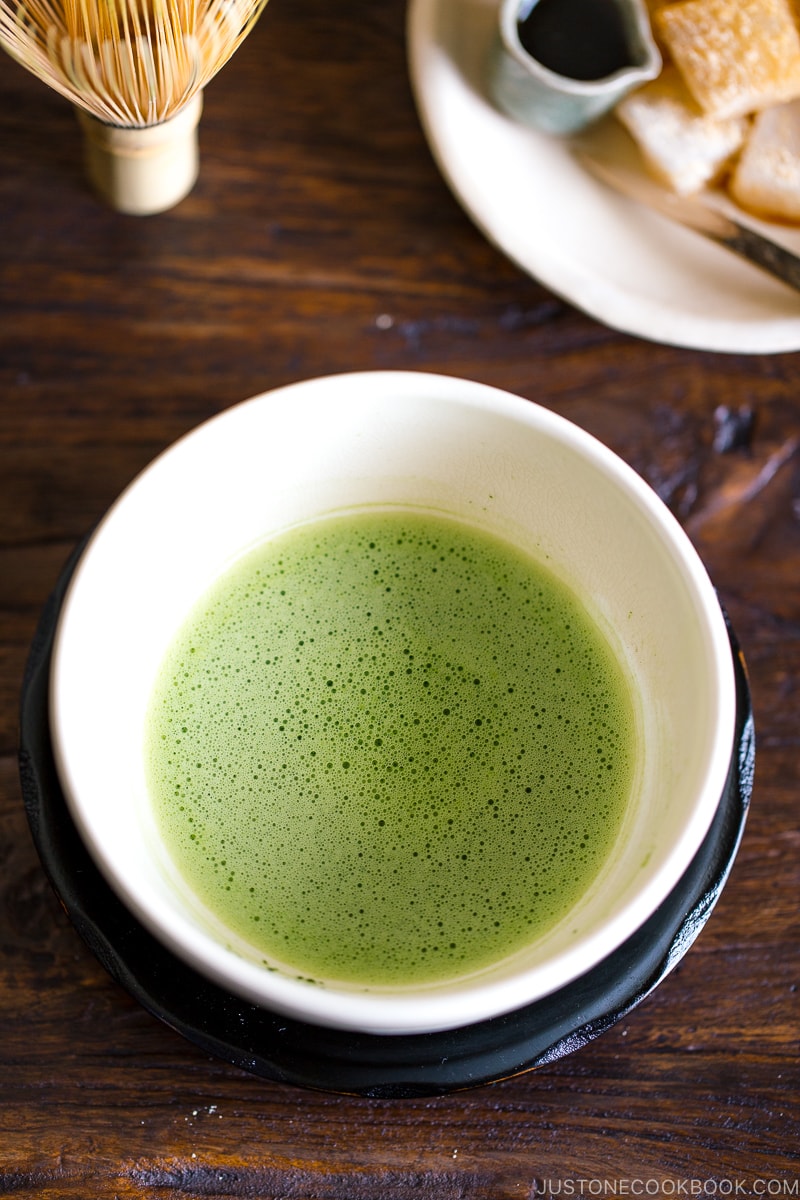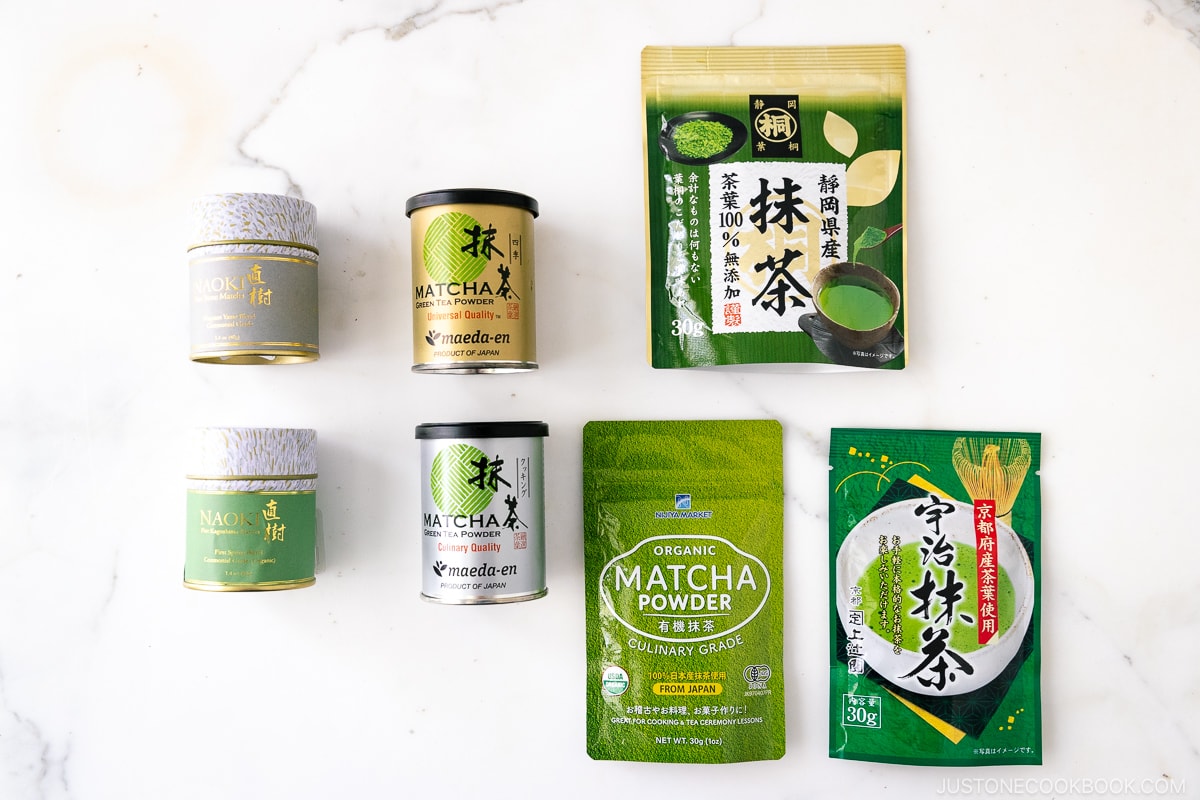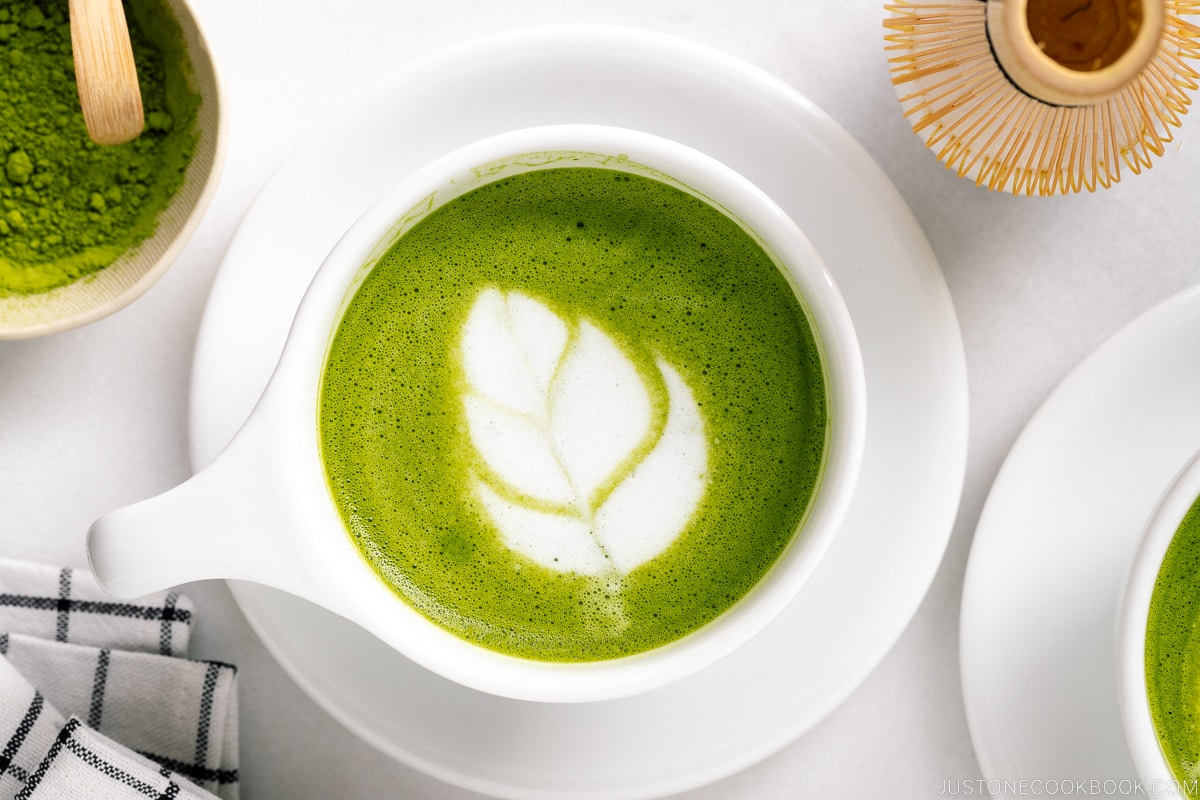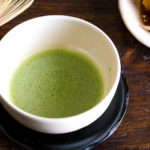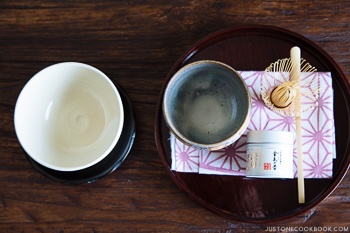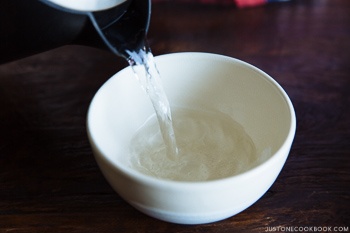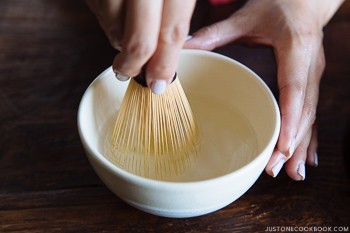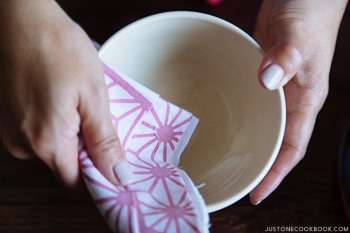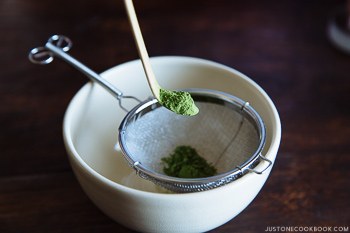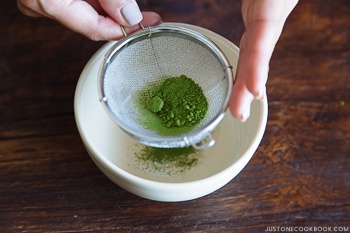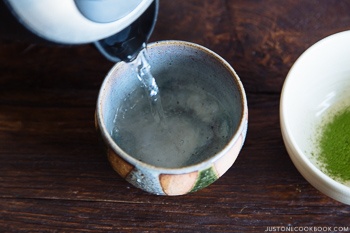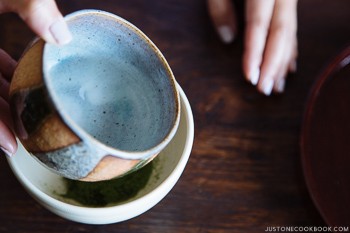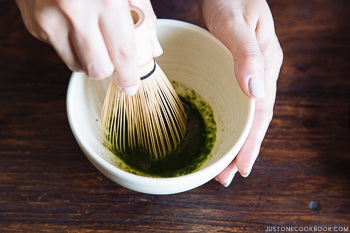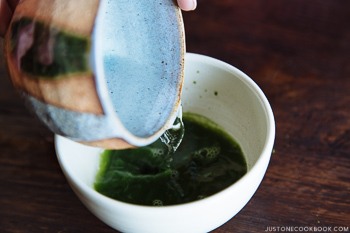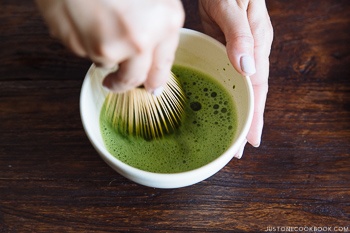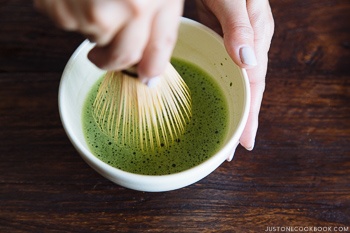Matcha drinking is an integral part of Japanese culture and I could remember vividly the day my grandma took me to the ochakai (お茶会), Japanese tea ceremony when I was eight. I got dressed up and pretended to be a grown-up “lady.” Even though I was too young to comprehend the full meaning of the rituals, I was captivated by the gracefulness of the host and the elaborate presentation. The first taste of matcha hit me as strong and bitter initially, but as the richness lingered in my mouth I began to appreciate its unique earthiness, and I’ve loved matcha ever since. Today I enjoy making matcha at home as a way to relax and for its many health benefits. To share with you this wonderful restorative Japanese tea, I’ve put together an informative guide and a video on how to make a perfect cup of matcha at home.
What is Matcha?
Matcha (pronounce as “ma(t)-CHA” 抹茶) is finely milled green tea powder or powdered green tea. Although matcha was originally enjoyed as a special pure beverage in the sacred tea ceremony, most people outside of Japan might have their first taste of matcha in the form of desserts or in latte or smoothie. If you haven’t tried matcha served its purest form, I sincerely hope you will give it a try after learning all about this amazing tea today. You can also get my Matcha Latte recipe and Matcha Smoothie recipe on the blog.
What’s the difference between matcha and regular loose-leaf green tea?
What makes matcha so special? Did you know matcha is the only form of tea in which the whole leaf is consumed? The tea leaves used for matcha are known as tencha leaves, considered the highest quality green tea leaves. At the plantations, farmers cover the designated tea plants for 20–30 days before harvest to avoid direct sunlight. This shading method increases chlorophyll production, which boosts both the amino acid L-theanine and the alkaloid caffeine in the tea leaves, which yields a sweet flavor and distinct aroma.
How is Matcha Made?
Health Benefits of Matcha
Why is Matcha Good for Your Health? This powdered green tea is well-recognized as an antioxidant powerhouse. Antioxidants are the magical chemical compounds and enzymes responsible for giving us younger-looking skin, boosting memory and concentration, increasing energy level and metabolism, and preventing a number of life-threatening diseases like cancer and heart disease. Many medical studies have chosen matcha as the research subject as matcha contains a most important polyphenol known as EGCG (epigallo-catechin gallate), which is known to help prevent cell damage and free radicals in the body. Japanese women, including myself, particularly love matcha for its ability to aid weight loss, detox, and anti-aging properties.
Does Matcha Contain Caffeine?
Matcha powder has as much caffeine as coffee, but it is absorbed by the body at a slower rate. That means matcha has less of the caffeine side effects. Matcha is a great option if you are looking for a coffee alternative drink that can give a boost of longer-lasting energy.
3 Things You Need to Make Matcha
Since matcha is in the form of a finely ground powder, the way we make it is very different from preparing loose-leaf green teas. In Japan, special tea utensils are typically used to prepare matcha. Below are the main tea utensils (and alternative suggestions) you will need to make matcha:
1. Chawan (Tea Bowl) 茶碗
Chawans are available in a wide range of sizes and styles, and different styles are used for thick and thin tea. Shallow bowls, which allow the tea to cool quickly are used in summer; deep bowls are used in winter to keep the tea hot for a longer time. Cleaning & Storage: Rinse the chawan well and store it in open-air to dry. After the surface has dried, allow additional time for the bowl to dry completely as ceramic tends to retain moisture internally.
2. Chasen (Tea Whisk) 茶筌
This bamboo whisk is called chasen and the one in the above image has 80 tines. It’s great for whisking matcha thoroughly to create nice rich foam. Cleaning & Storage: Rinse the chasen well without using detergent and dry and store upright (tines up) in the open air.
3. Chashaku 茶杓
A chashaku (‘tea scoop’) is a traditional Japanese tea utensil for measuring out a serving of powdered matcha. My chashaku is carved from bamboo, but some are made from rare woods or ivory. For one tea bowl, you will need 1 ½ heaping scoops of green tea powder (= about 2 g) and 2 to 2.4 oz (60-70 ml) of hot water. Where to Buy: You can purchase chashaku here. You can alternatively use a regular teaspoon. 1 teaspoon of the powdered match is 2 grams, and that’s what you’ll need for making one tea bowl. Cleaning & Storage: Gently wipe the chashaku with a soft dry cloth or tissue. Do not use water.
4. Optional Items
Extra Tea Bowl: If you’re using boiling water instead of measuring the exact temperature of hot water (185F/85C), prepare an extra tea bowl. You will need to pour the boiling water into the extra tea bowl first so it’ll cool down before whisking. Cloth: Use cloth such as 100% cotton to dry your tea bowl. Fine Sieve: A fine sieve helps to remove powdered lumps. If you don’t own one, make sure to spend extra time at step 8 (in the recipe) to blend well with green tea powder and hot water before pouring more hot water into the tea bowl.
2 Types of Matcha Green Tea
In general, you can find two grades of matcha: ceremonial or culinary grade. For making matcha tea at home, I recommend ceremonial-grade, which also comes in two different types. One is the thinner usucha (薄茶) and the other thicker type called koicha (濃茶). For beginner and everyday use, usucha is a great start. Koicha is more expensive but is the green tea of choice in Japanese tea ceremonies and special tea parties. It is much sweeter and more full-bodied than usucha. Culinary-grade is used in making matcha desserts and sweets.
Enjoy Matcha at Home
The Japanese tea ceremony (or we call sado (茶道), chado (茶道) or chanoyu (茶の湯) or ocha (お茶) in Japanese) is a choreographic ritual of preparing and serving matcha. The whole process is not about drinking tea; it’s all about aesthetics and considerations the host of the ceremony has for the guests with every movement and gesture. As a guest, there are a lot of etiquette and rules to follow when you attend the ceremony. For example, when matcha is served by a host, you hold the tea bowl with your right hand on its side and left hand under the cup. Then you will need to rotate the bowl a little to the right before drinking. Why do we “turn” the bowl? When the host places the tea bowl in front of you, you are looking at the most beautiful part of the bowl. It is rude if you put your mouth directly on it, therefore you turn the bowl to the side and drink. You can always experience the Japanese tea ceremony at tea houses, but I also wanted to show you how easily you can prepare delicious matcha at home and enjoy it without attending the Japanese tea ceremony. A simple ritual of making matcha is always a welcome relaxation at any time of the day. For me, the act of whisking and partaking the emerald green cup of tea reminds me to take a slower pace of life and appreciate the beauty of simplicity. I hope it will bring you the same calming experience as well.
Where to Buy Best Matcha
There are so many brands out there! My personal guide is to go with high quality matcha that is sourced directly from Japan. The powder should be a vibrant bright green color. You can also find a small tin or bag of matcha powder imported from Japan at Japanese grocery stores like Mitsuwa, Marukai, and Nijiya, or specialty tea shops.
How Long Does Matcha Last?
The shelf-life of an unopened package depends on how it is packaged. In general, high quality (unopened) green tea powder lasts for 6 months. It’s best to use up within 2-3 weeks of opening the package. You can do this easily by drinking more matcha green tea or making delicious desserts!
How to Store Matcha
To store, seal the package tightly and store it inside an airtight can. Avoid storing in direct sunlight and areas with high temperature or humidity.
More Matcha Recipes
Matcha Latte Matcha Smoothie Matcha Cookies Matcha Ice Cream
Wish to learn more about Japanese cooking? Sign up for our free newsletter to receive cooking tips & recipe updates! And stay in touch with me on Facebook, Pinterest, YouTube, and Instagram.
